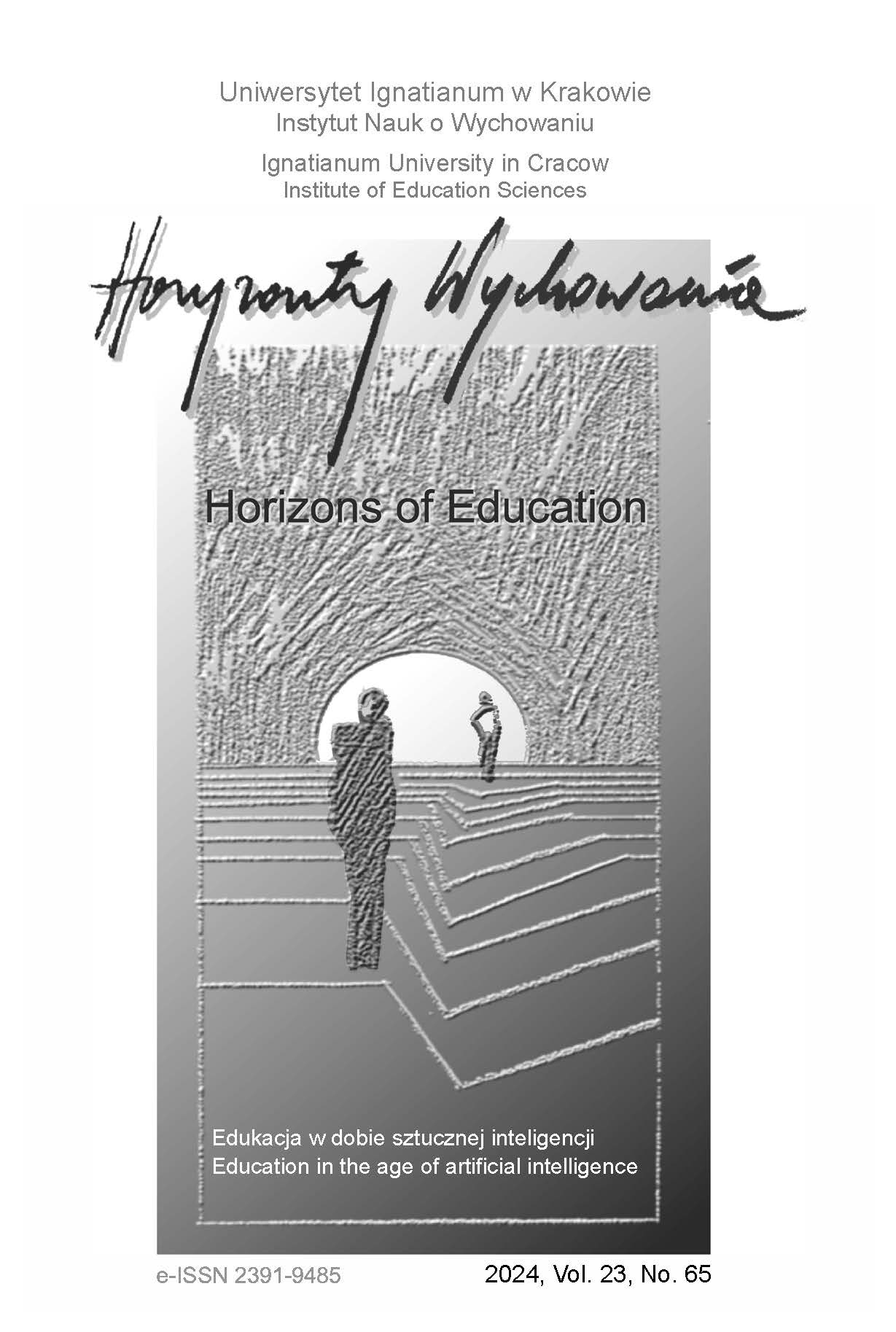Znaczenie kompetencji miękkich w procesie dostosowań rynku pracy do wymagań rewolucji 4.0
Abstrakt
CEL NAUKOWY: Celem artykułu jest poszerzenie wiedzy dotyczącej istoty i znaczenia kompetencji miękkich w procesie dopasowania zawodowego w warunkach rewolucji 4.0. na przykładzie sektora IT w wybranych krajach europejskich.
PROBLEM I METODY BADAWCZE: W badaniu skupiono się na próbie określenia potencjalnych cech przyszłego pracownika w aspekcie wymagań rewolucji 4.0. W badaniu, które miało miejsce w dniach 11–12 kwietnia 2023 roku, zostało przeanalizowanych łącznie 1870 ofert o pracę pobranych z międzynarodowego serwisu LinkedIn dla pięciu europejskich krajów.
PROCES WYWODU: W artykule wskazano na zmiany, jakie niesie ze sobą rewolucja 4.0 w zarządzaniu zasobami ludzkimi, ze szczególnym uwzględnieniem zmian zachodzących w profilu kompetencyjnym pracownika. Szczególną uwagę zwrócono na wzrost znaczenia kompetencji miękkich. Na podstawie przeprowadzonej kwerendy literatury przedmiotu oraz wyników badań własnych pod- jęto próbę identyfikacji kluczowych cech, istotnych z punktu widzenia rynku pracy, które wpływają na kryteria doboru zawodowego w branży IT.
WYNIKI ANALIZY NAUKOWEJ: Przeprowadzone badania wykazały, że najbardziej pożądany- mi kompetencjami miękkimi w wybranych zawodach IT są: komunikatywność pozwalająca na łatwość nawiązywania kontaktu z drugą osobą oraz motywacja do pracy. Na trzecim miejscu wskazano kreatywność.
WNIOSKI, REKOMENDACJE I APLIKACYJNE ZNACZENIE WPŁYWU BADAŃ: Badacze zwracają uwagę na fakt, że dla wypracowania skutecznej polityki personalnej ważna jest współpraca menedżerów mających świadomość rzeczywistych potrzeb organizacji w zakresie kompetencji wymaganych od pracowników oraz działów HR, aby opracować rozwiązanie problemu niedoborów zasobów pracy spowodowanych przez Przemysł 4.0.
Bibliografia
Armstrong, M. (2000). Zarządzanie zasobami ludzkimi (A. Unterschuetz, tłum.). Oficyna Ekonomiczna.
Aulbur, W., Arvind, CJ. i Bigghe, R. (2016). Skill Development for Industry 4.0. FICCI, Roland Berger. https://www.globalskillsummit.com/whitepaper-summary.pdf
Danneels, E. (2002). The dynamics of product innovation and firm competences. Strategic Management Journal, 23(12), 1095–1121. https://doi.org/10.1002/smj.275
Dębkowska, K., Kłosiewicz-Górecka, U., Szymańska, A., Ważniewski, P. i Zybertowicz, K. (2022). Kompetencje pracowników dziś i jutro. Polski Instytut Ekonomiczny.
Fonseca, L. (2018). Industry 4.0 and the digital society: concepts, dimensions and envisioned benefits. Proceedings of the International Conference on Business Excellence, 12(1), 386–397. https://doi.org/10.2478/picbe-2018-0034
Griffiths, D. (2015) Core competences. W: J. McGee i T. Sammut-Bonnici (red.), Wiley encyclopedia of management. T. 12: Strategic management. John Wiley & Sons.
Holstein-Beck, M. (1996). Jak być menedżerem? Centrum Informacji Menedżera.
Industriall Global Union. (2017). Globalne porozumienie ramowe w sprawie odpowiedzialności społecznej PSA Group. ACM Groupe PSA. https://www.industriallunion.org/sites/default/files/uploads/documents/
Kochmańska, A. (2016). Kompetencje miękkie w innowacyjnym przedsiębiorstwie. Organizacja i Zarządzanie. Zeszyty Naukowe Politechniki Śląskiej, 95, 189–199.
Lans, T., Verhees, F. i Verstegen, J. (2016). Social competence in small firms – fostering workplace learning and performance. Human Resources Development Quarterly, 27(3), 321–348. https://doi.org/10.1002/hrdq.21254
Levy-Leboyer, C. (1997). Kierowanie kompetencjami. Bilanse doświadczeń zawodowych, (M. Egeman, tłum.). Poltext.
Meijerink, J.G., Bondarouk, T. i Lepak, D.P. (2016). Employees as active consumers of HRM: Linking employees’ HRM competences with their perceptions of HRM service value. Human Resource Management, 55(2), 219–240. https://doi.org/10.1002/hrm.21719
Mietzner, D. i Kamprath M. (2013). A competence portfolio for professionals in the creative industries. Creativity and Innovation Management, 22(3), 280–294. https://doi.org/10.1111/caim.12026
Mikuła, B. (2001). Metody rozwoju kompetencji organizacji. W: C. Sikorski, T. Czapla i M. Malarski (red.), Przeszłość i przyszłość nauk o zarządzaniu. Metody i techniki zarządzania (s. 167–176). Katedra Zarządzania, Uniwersytet Łódzki.
Oleksyn, T. (2006). Zarządzanie kompetencjami. Teoria i praktyka. Oficyna Ekonomiczna.
Osiński, Z. (2010). Kompetencje miękkie absolwenta humanistycznych studiów wyższych a metody prowadzenia zajęć. W: B. Sitarska, K. Jankowski i R. Droba (red.), Studia wyższe z perspektywy rynku pracy (s. 57–66). Wydawnictwo Akademii Podlaskiej.
Sloman, M. (1997). Strategia szkolenia pracowników (J. Bijakowski, tłum.). Wydawnictwo Naukowe PWN.
Steffens, K. (2015). Competences, learning theories and MOOCs: Recent developments in lifelong learning. European Journal of Education, 50(1), 41–59. https://doi.org/10.1111/ejed.12102
Stodolak, S. (2009, 26 stycznia). Kompetencje a umiejętności. Psychologia Biznesu. http://www.psychologia.biz.pl/kompetencje-a-umiejetnosci/
Thierry, D. i Sauret, C. (1994). Zatrudnienie i kompetencje w przedsiębiorstwie w procesach zmian, (H. Bełżecka i M. Egeman, tłum.). Poltext.
Walkowiak, R. (2004). Model kompetencji menedżerów organizacji samorządowych. Wydawnictwo Uniwersytetu Warmińsko-Mazurskiego.
Whiddett, S. i Hollyforde, S. (2003). Modele kompetencyjne w zarządzaniu zasobami ludzkimi (G. Sałuda, tłum.). Oficyna Ekonomiczna.
World Economic Forum. (2020, 22 stycznia). Jobs of tomorrow. Mapping opportunity in the new economy.https://www.weforum.org/reports/jobs-of-tomorrow-mapping-opportunity-in-the-new-economy
Włoch, R. i Śledziewska, K. (b.d.). Kompetencje przyszłości. Jak je kształtować w elastycznym ekosystemie edukacyjnym? DELab UW.
Copyright (c) 2023 Horyzonty Wychowania

Utwór dostępny jest na licencji Creative Commons Uznanie autorstwa – Bez utworów zależnych 4.0 Międzynarodowe.
Uwagi dotyczące praw autorskich
Autorzy publikujący w tym czasopiśmie wyrażają zgodę na następując warunki:
- Autorzy zachowują prawa autorskie, przyznając czasopismu prawo do pierwszej publikacji swojego tekstu jednocześnie zarejestrowanego pod numerem licencji CC BY-ND, która pozwala innym na korzystanie z tego tekstu z uznaniem autorstwa tekstu oraz pierwotnej publikacji w tym czasopiśmie.
- Autorzy proszeni są o nawiązywanie odrębnych, dodatkowych porozumień wynikających z umowy, dotyczących dystrybucji opublikowanej w czasopiśmie wersji tekstu nie na prawach wyłączności (np. opublikowanie go w repozytorium instytucji lub w innym czasopiśmie), z potwierdzeniem pierwszej publikacji w tym czasopiśmie.
Wyraża się zgodę i zachęca autorów do publikacji ich tekstu w Internecie (np. w repozytorium instytucji lub na jej stronie internetowej) przed lub podczas procesu składania tekstu jako, że może to prowadzić do korzystnych wymian oraz wcześniejszego i większego cytowania opublikowanego tekstu (Patrz The Effect of Open Access). Zalecamy wykorzystanie dowolnego portalu stowarzyszeń badawczych z niżej wymienionych:





